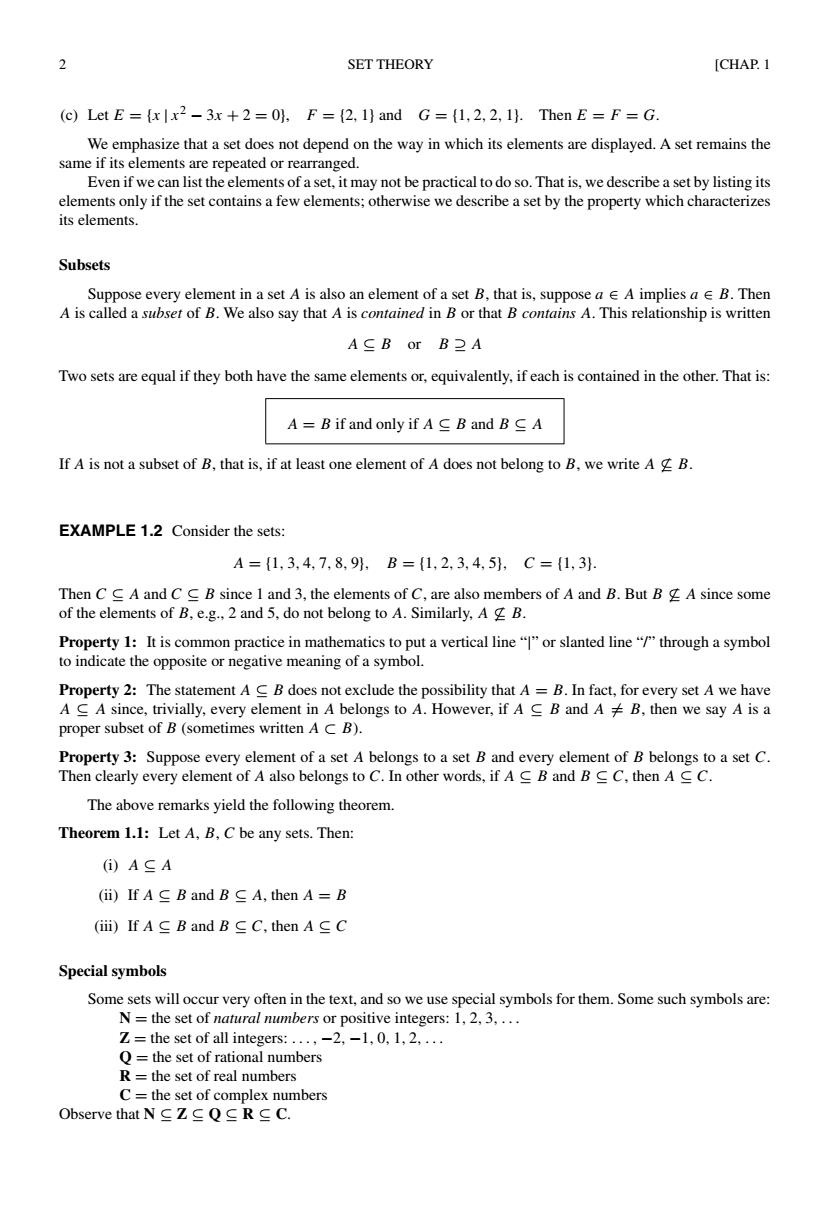正在加载图片...

2 SET THEORY [CHAP.1 (c)Let E ={xlx2-3x+2=0),F=(2,1)and G=(1,2,2,1).Then E=F=G We emphasize that a set does not depend on the way in which its elements are displayed.A set remains the same if its elements are repeated or rearranged. Even if we can list the elements of a set,it may not be practical to do so.That is,we describe a set by listing its elements only if the set contains a few elements;otherwise we describe a set by the property which characterizes its elements. Subsets Suppose every element in a set A is also an element of a set B,that is,suppose aA implies a B.Then A is called a subset of B.We also say that A is contained in B or that B contains A.This relationship is written A≤BorB2A Two sets are equal if they both have the same elements or,equivalently,if each is contained in the other.That is: A=B if and only if A≤B and B∈A If A is not a subset of B,that is,if at least one element of A does not belong to B,we write A g B. EXAMPLE 1.2 Consider the sets: A={1,3,4,7,8,91,B={1,2,3,4,5,C={1,3} Then CC A and CC B since 1 and 3,the elements of C,are also members of A and B.But B A since some of the elements of B,e.g.,2 and 5,do not belong to A.Similarly,A B. Property 1:It is common practice in mathematics to put a vertical line""or slanted line""through a symbol to indicate the opposite or negative meaning of a symbol. Property 2:The statement A B does not exclude the possibility that A=B.In fact,for every set A we have A C A since,trivially,every element in A belongs to A.However,if A C B and A B,then we say A is a proper subset of B(sometimes written AC B). Property 3:Suppose every element of a set A belongs to a set B and every element of B belongs to a set C. Then clearly every element of A also belongs to C.In other words,if A B and BCC,then A CC. The above remarks yield the following theorem. Theorem 1.1:Let A,B,C be any sets.Then: ①)A≤A (i)IfA≤B and B≤A,then A=B (ii)IfA≤B and B≤C,then A∈C Special symbols Some sets will occur very often in the text,and so we use special symbols for them.Some such symbols are: N=the set of natural numbers or positive integers:1,2,3.... Z=the set of all integers:...,-2,-1,0,1,2,... Q the set of rational numbers R=the set of real numbers C=the set of complex numbers Observe that NCZCQCRC C.2 SET THEORY [CHAP. 1 (c) Let E = {x | x2 − 3x + 2 = 0}, F = {2, 1} and G = {1, 2, 2, 1}. Then E = F = G. We emphasize that a set does not depend on the way in which its elements are displayed. A set remains the same if its elements are repeated or rearranged. Even if we can list the elements of a set, it may not be practical to do so. That is, we describe a set by listing its elements only if the set contains a few elements; otherwise we describe a set by the property which characterizes its elements. Subsets Suppose every element in a set A is also an element of a set B, that is, suppose a ∈ A implies a ∈ B. Then A is called a subset of B. We also say that A is contained in B or that B contains A. This relationship is written A ⊆ B or B ⊇ A Two sets are equal if they both have the same elements or, equivalently, if each is contained in the other. That is: A = B if and only if A ⊆ B and B ⊆ A If A is not a subset of B, that is, if at least one element of A does not belong to B, we write A ⊆ B. EXAMPLE 1.2 Consider the sets: A = {1, 3, 4, 7, 8, 9}, B = {1, 2, 3, 4, 5}, C = {1, 3}. Then C ⊆ A and C ⊆ B since 1 and 3, the elements of C, are also members of A and B. But B ⊆ A since some of the elements of B, e.g., 2 and 5, do not belong to A. Similarly, A ⊆ B. Property 1: It is common practice in mathematics to put a vertical line “|” or slanted line “/” through a symbol to indicate the opposite or negative meaning of a symbol. Property 2: The statement A ⊆ B does not exclude the possibility that A = B. In fact, for every set A we have A ⊆ A since, trivially, every element in A belongs to A. However, if A ⊆ B and A = B, then we say A is a proper subset of B (sometimes written A ⊂ B). Property 3: Suppose every element of a set A belongs to a set B and every element of B belongs to a set C. Then clearly every element of A also belongs to C. In other words, if A ⊆ B and B ⊆ C, then A ⊆ C. The above remarks yield the following theorem. Theorem 1.1: Let A, B, C be any sets. Then: (i) A ⊆ A (ii) If A ⊆ B and B ⊆ A, then A = B (iii) If A ⊆ B and B ⊆ C, then A ⊆ C Special symbols Some sets will occur very often in the text, and so we use special symbols for them. Some such symbols are: N = the set of natural numbers or positive integers: 1, 2, 3,... Z = the set of all integers: ..., −2, −1, 0, 1, 2,... Q = the set of rational numbers R = the set of real numbers C = the set of complex numbers Observe that N ⊆ Z ⊆ Q ⊆ R ⊆ C.����